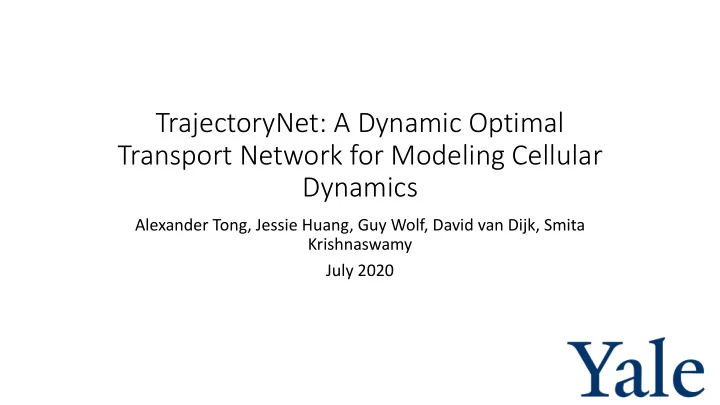

TrajectoryNet: A Dynamic Optimal Transport Network for Modeling Cellular Dynamics Alexander Tong, Jessie Huang, Guy Wolf, David van Dijk, Smita Krishnaswamy July 2020
Motivation Longitudinal inference from cross sectional snapshot measurements
Motivation Longitudinal inference from cross sectional measurements Tasks: • Predict trajectory of a point
Motivation Longitudinal inference from cross sectional measurements Tasks: • Predict trajectory of a point • Predict distribution at test timepoint
Normalizing Flows (NFs) • Begin with a simple distribution • Apply an invertible transformation(s) • Use change of variables to calculate probability
Deep Normalizing Flows (NFs) • Apply a series of transformations • Use change of variables to calculate probability
Continuous Normalizing Flows Cannot model: [Chen et al. 2018]
CNFs create continuous paths Creates continuous paths, but they may not be biologically plausible — no restriction on circuitous paths! [Chen et al. 2018]
Obtaining straight paths via regularization Penalize path energy : the squared L2-norm of the derivatives
Regularized CNF approximates dynamic optimal transport Dynamic OT: 𝜈 𝜉 Subject to: Benamou and Brenier 2000
Regularized CNF approximates dynamic optimal transport Dynamic OT: regularized CNF 𝜈 𝜉 Subject to:
CNFs model Dynamic Optimal Transport
Dynamic OT via TrajectoryNet • Dynamic OT via TrajectoryNet can be utilized to infer continuous trajectories of any populations adhering to energy or transport constraints • Population migration • Disease spread • However, cellular systems are more constrained, and other domain specific priors apply
Single Cell Embryonic Stem Cell Data 27 day timecourse collected at 5 timepoints, measurements destroy cells at each timepoint (same cell cannot be measured at more than one timepoint)
Inferring Continuous Flow in Static Snapshots genes cells
Additional Properties of cells 1. Cells are not simply transported from one timepoint to another, they cells divide and die. 2. Cells cannot travel in straight paths through Euclidean space in terms of measured dimensions, cells only travel along a cellular manifold. 3. Though cells are destroyed when measured, we can estimate their direction of transition-based RNA velocity
Cell Death and Growth • Allowing unbalanced transport can let cells “die” instead of moving them to implausible locations • Unbalanced transport hard to achieve dynamically • We use discrete optimal transport to assign growth and death rates Liero et al. 2018
Cellular Manifolds Implausible path Cells have to transition through allowable parts of the state space Enforce this with a density penalty. Based on a knn density estimate
Velocity Regularization RNA Velocity, estimate of direction of change [La Manno et al. 2018 Velocyto; Volker et al. ScVelo]
Toy Example
Continuous Trajectories in Single Cell Data Single Cell Trajectories
Results — Embryoid body dataset • Wasserstein distance between predicted and true distributions for different left out timepoints • Different regularizations have different assumptions and tradeoffs
Tracing Ancestry
Summary • Energy regularized CNF performs dynamic optimal transport to find flows between cross-sectional populations • TrajectoryNet includes additional regularizations that allow for optimal transport on a manifold, with growth and death of individuals over time, and respecting individual velocity data • Trajectories of individual cells, and gene expression activity can be inferred
Thanks! Code: https://github.com/krishnaswamylab/TrajectoryNet Paper: https://arxiv.org/abs/2002.04461 Lab Website: https://www.krishnaswamylab.org
Recommend
More recommend